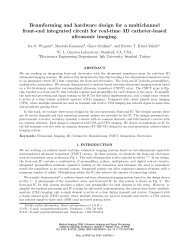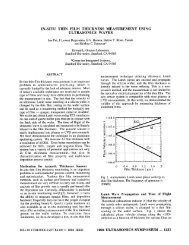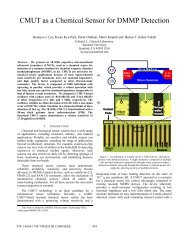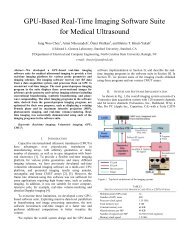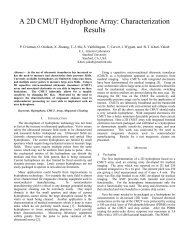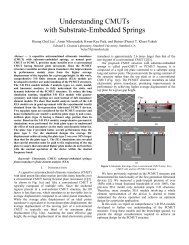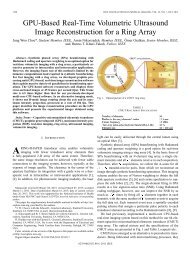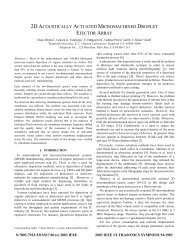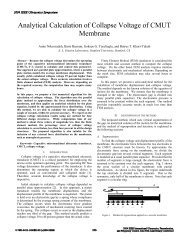(CMUT) as a chemical sensor for DMMP detection - Khuri-Yakub ...
(CMUT) as a chemical sensor for DMMP detection - Khuri-Yakub ...
(CMUT) as a chemical sensor for DMMP detection - Khuri-Yakub ...
- No tags were found...
Create successful ePaper yourself
Turn your PDF publications into a flip-book with our unique Google optimized e-Paper software.
1122 K.K. Park et al. / Sensors and Actuators B 160 (2011) 1120–1127Fig. 2. Optical pictures of a <strong>CMUT</strong> array. (a) 64 sensing units (element) are located in a 5 mm × 2.5 mm die. (b) Top view of three elements. Circular pattern represents manyunit resonators (Fig. 1) in a single element. In order to reduce the mechanical cross talk between elements, through-wafer isolation trenches are used between elements.sheet resistance of 20 /□. As a result the effective m<strong>as</strong>s of plateis reduced. Moreover, the single crystal plate transferred froman SOI wafer h<strong>as</strong> a better thickness uni<strong>for</strong>mity and lower residualstress compared to the silicon nitride plate <strong>for</strong>med using theLPCVD process. The new process provides precise control of theplate dimensions, such <strong>as</strong> a plate thickness and a cavity shape, andalso the process is capable of fabricating a very thin vacuum cavity<strong>as</strong> low <strong>as</strong> 40 nm. This low value <strong>for</strong> the cavity height reduces therequired DC bi<strong>as</strong> voltage to establish a high electric field strengththat results in a good electromechanical coupling.2.2.2. Structure of multi-resonatorsA single <strong>CMUT</strong> <strong>sensor</strong> unit (channel) is composed of 100s to1000s of identical resonant structures. These resonators in thechannel are designed not to be mechanically coupled to each other,but to be electrically connected in parallel. There<strong>for</strong>e, one can electricallyaccess the parallel combination of all resonators throughtwo bond pads, i.e., a signal and a ground pad (Fig. 2). The 18 MHzresonator used <strong>for</strong> the <strong>chemical</strong> <strong>detection</strong> is composed of 1000 resonators,each made of a single crystal silicon plate with a radius of9 m and a thickness of 0.5 m.This multi-resonator configuration h<strong>as</strong> several benefits over thesingle resonator configuration. First, the effect on the lumped signaldue to a failure of a few resonators during operation is not significant.As a result, the <strong>sensor</strong> is reliable and operational even withminor external damage. In addition, a larger number of resonatorsresult in a larger total effective capacitance of the device. As a result,the ratio of unwanted par<strong>as</strong>itic capacitance due to electrical signalpads and external bond-wires to the active device capacitancebecomes smaller. Moreover, the number of resonators can be used<strong>as</strong> an additional design parameter to adjust the lumped impedanceof the device. For example, the lumped motional impedance is acritical parameter in the oscillator design in terms of thermal noiseand impedance matching. This motional impedance is inverselyproportional to the number of resonators and can be adjusted withoutchanging the dimensions of individual resonators [18].2.3. Device characterization<strong>CMUT</strong> resonators are characterized electrically using animpedance analyzer (Model 4294A, Agilent Technologies, SantaClara, CA). Important parameters of the resonant structure, such <strong>as</strong>the series and parallel resonant frequencies and Q, are extractedfrom this me<strong>as</strong>urement. The me<strong>as</strong>ured input impedance of the<strong>CMUT</strong> (Fig. 3) shows a series resonant frequency of 17.3 MHz and aparallel resonant frequency of 18.2 MHz.In an ideal resonator model, Q of both resonant frequenciesshould be comparable [16]. However, <strong>as</strong> the <strong>CMUT</strong> is made of multipleresonators connected in parallel, the resonator-to-resonatornon-uni<strong>for</strong>mity affects the quality factor. As Lee [19] discussed, thedegradation of the quality factor of the series resonant frequencyis more severe than that of the parallel resonant frequency, whichis also observed in our me<strong>as</strong>urement (Fig. 3). The me<strong>as</strong>ured qualityfactor of series resonant frequency (27) is much lower thanFig. 3. (a) Me<strong>as</strong>ured input impedance of 18-MHz <strong>CMUT</strong>. (b) 6-elements equivalent circuit model with extracted component values from (a).



